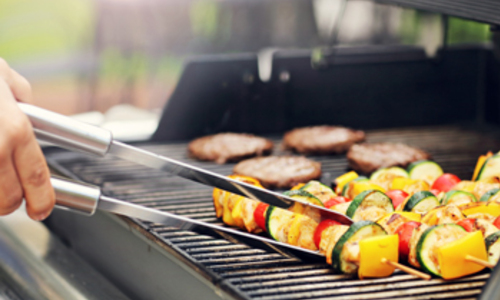5-minute read
|
PGS Grill
Grilling is deeply ingrained in American culture, a cherished tradition that brings families and friends together. Whether you live in a bustling apartment building or a cozy suburban neighborhood, there's something magical about firing up the grill during barbecue season. In this article, we’ll explore the cultural significance of grilling in America, delve into safety tips, and provide practical advice for those who enjoy cooking outdoors in communal spaces.
Gas grills are the go-to choice for many Americans, thanks to their convenience and efficiency. Unlike charcoal grills, which require more prep time and cleanup, gas grills ignite easily and offer consistent heat. While some purists argue that charcoal imparts a unique smoky flavor, the difference isn’t drastic enough to sway most cooks.
Gas grills typically come with one to five burners, and the grilling surface may consist of stainless steel sheets, porcelain-covered steel bars, stainless steel bars, or iron grids. Among the top-rated models are the PSG A-Series and T-Series Grills.
The A-Series grills are crafted from durable materials like permanent mold aluminum, commercial-grade stainless steel, brass, and porcelain-on-steel components. Their price varies based on BTU ratings and cooking surface size.
The T-Series is designed for heavy-duty use in commercial settings. Its robust construction ensures longevity, even with daily wear and tear. A 60-minute gas flow timer automatically shuts off the gas supply if the grill is accidentally left on. This feature serves as a safeguard against potential hazards associated with leaving the gas on overnight.
California’s mild climate makes outdoor cooking a joy, especially for apartment dwellers. However, it’s essential to familiarize yourself with local regulations regarding grilling on patios and balconies. The California Fire Code outlines several guidelines:
Proper usage is key to preventing accidents. According to the National Fire Incident Reporting System, 47% of grill fires stem from misuse or operational errors. When handling a gas grill, remember these precautions:
After a communal grilling session, it’s important to clean up thoroughly. Maintaining a tidy shared space fosters goodwill among neighbors and ensures everyone enjoys a pleasant environment for future gatherings.
A commercial grill requires seasoning before its initial use. Properly seasoned grates heat faster and cook food more uniformly. The primary goal of seasoning a new grill is to eliminate contaminants like dust or metal shavings left over from manufacturing or shipping. Additionally, seasoning helps seal the pores of the metal surface.
The grates needing seasoning include stainless steel or cast iron grates and their emitter plates.
Regular cleaning is also vital. Refer to the owner’s manual for specific instructions, as some commercial grills can be cleaned with a brush, while others require specialized cleaners and gentle soap solutions.
Few things compare to sinking your teeth into perfectly grilled meat. The foundation of a great barbecue lies in selecting the right cuts. Even seasoned grill masters can benefit from reviewing these three essential guidelines for choosing meats:
For premium quality, choice-grade meat is an excellent choice. It strikes a balance between tenderness and marbling without breaking the bank. Prime-grade meat is the gold standard, though it comes at a higher price due to rarity. Only 2 out of 100 cows produce prime beef. Select-grade meat is budget-friendly but lacks the depth of flavor offered by its counterparts.
There’s no reason why you can’t master the art of grilling on your community’s shared grill. Familiarity with the equipment is half the battle, but knowing the basics of grilling gear takes you further. Essential tools include a meat fork, spatula, tongs, carving board, marinade brush, meat thermometer, and slicing knife.
No barbecue is complete without condiments like sauces, marinades, and spice rubs. Experiment with store-bought options or create your own recipes. A public grill fosters connections that a private setup cannot replicate. So, embrace your apartment’s communal grill and host a barbecue party! Have questions or need more details? Get in touch with us today—we’d love to assist you! Bus Camera View,Bus Camera,Bus Monitoring,Car Mirror Camera Shenzhen Zhitong Yingchuang Electronic Technology Co., Ltd. , https://www.visualdriving.comGrilling Together: A Community Experience

Fascinating Facts About American Barbecue
Gas Grills Dominate the Outdoor Cooking Scene
PSG also provides built-in options like access doors, drawer storage units, and beverage centers.
Apartment Grilling Safety Tips
Preparing Commercial Grills for Use
Choosing Meats for Grilling
Getting Ready for BBQ Success
Outdoor Grilling in a Community
Return to Blog